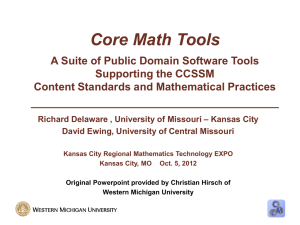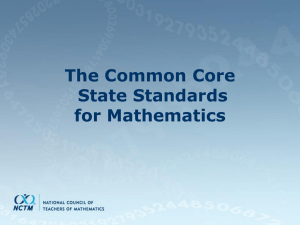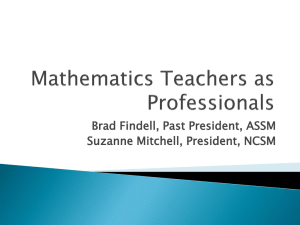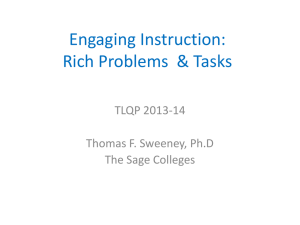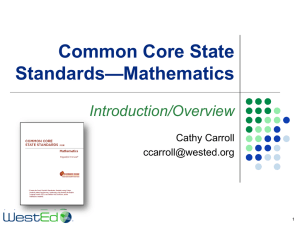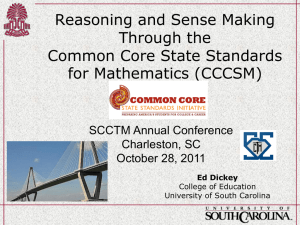An overview of Common Core State Standards for Math and South
advertisement
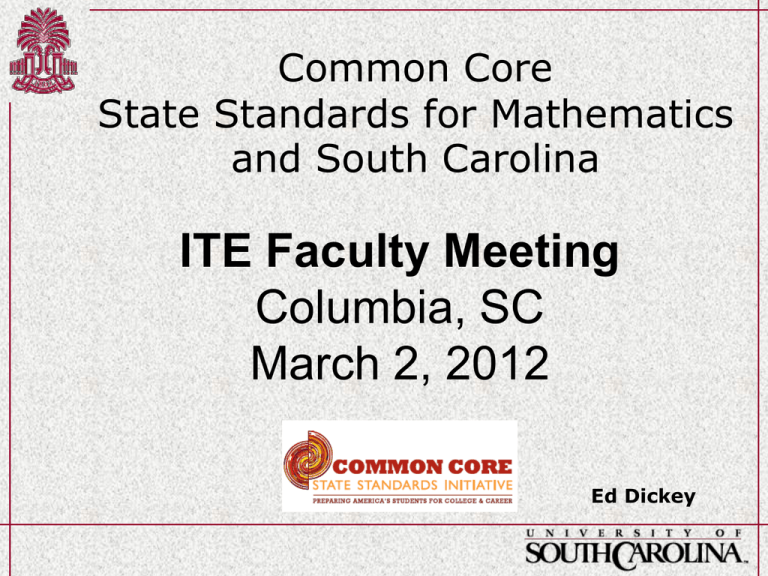
Common Core State Standards for Mathematics and South Carolina ITE Faculty Meeting Columbia, SC March 2, 2012 Ed Dickey Mathematics for the 21st Century Classroom • U.S. Secretary of Education Arne Duncan at NCTM Annual Meeting, 15 April 2011 • “Curricular materials cover so much ground too superficially, failing to provide students with an understanding of the concepts that are essential for success.” • “Tests don’t always measure what’s important, or provide information back to you to help you improve.” Common Core Standards • Sponsored by the Council of Chief State School Officers (CCSS) and the National Governors Association (NGA) • First significant attempt to systematically align K-12 standards across the U.S. • Building on NCTM’s standards documents from 1980, 1989, 2000, 2006, and 2009 • NCTM among groups providing feedback Common Core Standards • Different from most current state standards • Based on most recent research regarding students’ learning trajectories related to mathematics content • Includes detailed description of the way mathematics is learned and used by students (Mathematical Practice) Common Core Development • Initially 48 states and three territories signed on • Final Standards released June 2, 2010, at www.corestandards.org • Adoption required for Race to the Top funds • As of today, 46 states have officially adopted (plus DC, US VI, & N. Mariana I) • Non-adopters: Virginia and the P-Governors Benefits for States and Districts • • • • Allows collaborative professional development based on best practices Allows development of common assessments and other tools (SC in SMARTER Balanced and PARCC) Enables comparison of policies and achievement across states and districts Creates potential for collaborative groups to get more economic mileage (“economy of scale”) for: – Curriculum development, assessment, and professional development South Carolina • State Board of Education adopted the Common Core for SC on July 14, 2010 • In November 2010, Mick Zais was elected Superintendent of Education and with Governor Haley has chosen to not apply for Race to the Top funds • In May 2011 Senator Mike Fair introduced a Proviso in the SC Budget to prohibit the SC Department of Education from spending related to the Common Core • In October 2011, the SC Board and Department of Education continue to move toward implementation South Carolina 2012 • In February 2012 the state Board of Education selected Smarter Balanced Assessment Consortium as the SC assessment system (3 members opposed) • Sen. Fair re-introduced S. 604 to block fund for the Common Core (moving to full Senate with negative recommendation for the Education subcommittee) • SC remains on a timeline to implement the Common Core by the 2014-2015 school year. • Opposition for political and other reasons BOTH from the right and the left. CCSSM CCSSM stands for Common Core State Standards for Mathematics Implementation in SC • Where are we in mathematics? • Some are aware and working diligently on implementation • Others might have been waiting to see if it would go away • Reality HAS set in… Challenges • • • • • Understanding learning progressions Vertical articulation Addressing the mathematical practices Emphasis on understanding High school courses vs standards Common Core - Standards • Standards are content statements. An example content statement is: “Use properties of operations to generate equivalent expressions.” • Progressions of increasing complexity from grade to grade • Requires attention to vertical articulation… • … particularly in transition from current standards Coherence • Articulated progressions of topics and performances that are developmental and connected to other progressions • Conceptual understanding AND procedural skills stressed equally NCTM states coherence also means that instruction, assessment, and curriculum are aligned Focus • Key ideas, understandings, and skills are identified • Deep learning of concepts is emphasized – That is, time is spent on a topic and on learning the topic well. This counters the “mile wide, inch deep” criticism leveled at most current U.S. standards. CCSSM • Word Cloud Learning Trajectories • Descriptions of children’s thinking and learning in a specific mathematical domain, and • a related conjectured route through a set of instructional tasks designed to engender those mental processes or actions hypothesized to move children through a developmental progression of levels of thinking, • created with the intent of supporting children’s achievement of specific goals in that mathematical domain. • Clements and Sarama, 2004 Learning Trajectories or Progressions • Teachers use ordered set of instructional experiences and tasks • Students think and learn through a developmental progression of levels to reach goal • Van Hiele Levels in Geometry (since 1970s) • Formative Assessments more recently Adding Fractions • As expressed by Hung-Hsi Wu, in Fall 2011, American Educator • In the past… • Memorize steps and mimic process without attention to understanding • Adding whole numbers is “combining”… how is adding of fractions combining things? Adding Fractions Learning Trajectory • In CCSSM, learning trajectories for adding fraction spans grades 3-5 • In grade 3, students learn to think of a fraction as a point on a line. • Unit fractions, like 1/6 and copies of the unit like 5/6 Japan • Mathematics curriculum in Japan has long used learning trajectories developed from lesson studies. CCSSM Mathematical Practices • Common Core includes a set of Standards of Mathematical Practices that all teachers should develop in their students. • Similar to NCTM’s Mathematical Processes from the Principles and Standards for School Mathematics. • Practices MUST be assessed 8 CCSSM Mathematical Practices 1. Make sense of problems and persevere in solving them. 2. Reason abstractly and quantitatively. 3. Construct viable arguments and critique the reasoning of others. 4. Model with mathematics. 8 CCSSM Mathematical Practices 5. Use appropriate tools strategically. 6. Attend to precision. 7. Look for and make use of structure. 8. Look for and express regularity in repeated reasoning. High School Pathways • Four years of mathematics: – One course in each of the first two years – Followed by two options for year three and a variety of relevant courses for year four • Course descriptions – Define what is covered in a course – Are not prescriptions for the curriculum or pedagogy High School Pathways • Pathway A: Consists of two algebra courses and a geometry course, with some data, probability and statistics infused throughout each (traditional) • Pathway B: Typically seen internationally that consists of a sequence of 3 courses each of which treats aspects of algebra, geometry and data, probability, and statistics. NCTM President Michael Shaughnessy • An Opportune Time to Consider Integrated Mathematics March, 2011 • “Students need to see mathematics as an integrated whole, with connections across the content domains... • …the United States will never show well in international comparisons of mathematics performance as long as other countries have an integrated mathematics, and we take a “layer cake” approach. • … we have an unprecedented opportunity… to integrate the content of our secondary mathematics…” Promising, Opportune… but Perfect? Problem areas: • CCSSM has never been field tested • Can the assessments address understanding and measure the Practices? • How to accommodate exceptional learners? • Learning trajectories require careful vertical articulation Not Perfect … Problem areas: • Too little technology particularly in K-8 • No statistics in K-5 • Piling on in Grade 6 Math Common Core Resources • http://www.nctm.org/standards/mathcommoncore/ 2012 Institutes High School Reasoning & Sense Making: July 24-26, Los Angeles, California K-8 Algebra Readiness Institute: July 31- August 2, Atlanta, Georgia SCCTM Additional Information • For grades preK-8, a model of implementation can be found in NCTM’s Curriculum Focal Points www.nctm.org/cfp • For the secondary level, please see NCTM’s Focus in High School Mathematics: Reasoning and Sense Making www.nctm.org/FHSM Citations • CCSSO/NGA. (2010). Common core state standards for mathematics. Washington, DC: Council of Chief State School Officers and the National Governors Association Center for Best Practices. Retrieved from http://corestandards.org/ • Clements, D., & Sarama, J. (2004). Learning trajectories in mathematics education. Mathematical Thinking and Learning, 6(2), 81-89. • Clements, D., & Sarama, J. (2009). Learning and Teaching Early Math: The learning Trajectories Approach.New York: Routledge. Citation • Daro, Phil, Frederic Moser, and Tom Corcoran( (2011) Learning Trajectories in Mathematics. Retrieved from http://www.cpre.org/ccii/images/stories/ccii_pdfs/learning%20trajectories%2 0in%20math_ccii%20report.pdf • Dojinsha, Kyoiku. Mathematics Workbook (Grade 1 to 6). Global Education Resources, http://www.globaledresources.com/ • National Council of Teachers of Mathematics. Position Statement on Teacher Evaluation. Retrieved from http://www.nctm.org/about/content.aspx?id=31267 • Wu, Hung-Hsi (2011) Phoenix Rising: Bring the Common Core State Mathematics Standards to Life. American Educator, Fall 2011. Retrieved from http://www.aft.org/pdfs/americaneducator/fall2011/Wu.pdf Web Resources • Common Core: http://www.corestandards.org • Math Common Core Resources: http://www.nctm.org/standards/mathcommoncore/ • PARRC: http://www.parcconline.org/ • SBAC: http://www.k12.wa.us/smarter/ • South Carolina Common Core: http://ed.sc.gov/agency/pr/standards-andcurriculum/South_Carolina_Common_Core.cfm Thank you… ed.dickey@sc.edu www.ite.sc.edu/dickey.html
